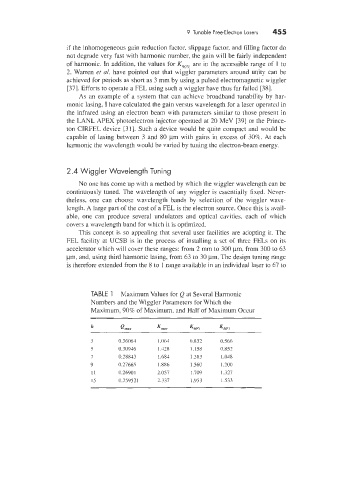Page 495 - Tunable Lasers Handbook
P. 495
9 Tunable Free-Electron Lasers 455
if the inhomogeneous gain reduction factor, slippage factor. and filling factor do
not degrade very fast with harmonic number, the gain will be fairly independent
of harmonic. In addition, the values for K,,, are in the accessible range of 1 to
2. Warren er al. have pointed out that wiggler parameters around unity can be
achieved for periods as short as 3 mm by using a pulsed electromagnetic wiggler
[37], Efforts to operate a FEL using such a wiggler have thus far failed [38].
As an example of a system that can achieve broadband tunability by har-
monic lasing. I have calculated the gain versus wavelength for a laser operated in
the infrared using an electron beam with parameters similar to those present in
the LANL APEX photoelectron injector operated at 20 MeV [39] or the Prince-
ton CIRFEL device [31]. Such a device would be quite compact and would be
capable of lasing between 3 and 80 ym with gains in excess of 30%. At each
harmonic the wavelength m ould be varied by tuning the electron-beam energy.
2.4 Wiggler Wavelength Tuning
No one has come up with a method by which the wiggler wavelength can be
continuously tuned. The wavelength of any wiggler is essentially fixed. Never-
theless, one can choose wavelength bands by selection of the wiggler wate-
length. A large part of the cost of a FEL is the electron source. Once this is akail-
able. one can produce several undulators and optical cavities, each of ivhich
covers a v;avelength band for which it is optimized.
This concept is so appealing that several user facilities are adopting it. The
FEL facility at UCSB is in the process of installing a set of three FELs on its
accelerator which will cover these ranges: from 2 mm to 300 ym, from 300 to 63
pm. and, using third harmonic lasing, from 63 to 30 ,urn. The design tuning range
is therefore extended from the 8 to 1 range available in an individual laser to 67 to
TABLE 1 Maximum Values for Q at Several Harmonic
Numbers and the Wiggler Parameters for Which the
Maximum, 90% of Maximum, and Half of Maximum Occur
7 0.36061 1.061 0.832 0.566
0.30046 1 .428 1.158 0.852
7 0.28843 1.681 1.383 1.018
9 0 21665 1.886 1.560 1.2OC
11 0.26901 2.057 1.709 1.377
15 0.259521 2 337 1.953 1533

